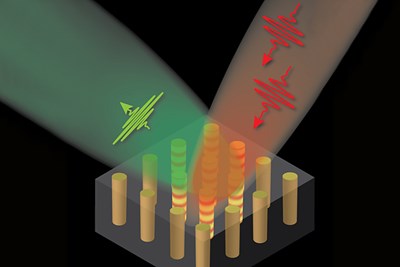Jan
1
Metamaterial Uses Light to Replace Electrons
January 1, 2019 | Leave a Comment
University of Massachusetts Lowell is part of a research team that is taking the technology of manipulating light in a new direction. The research led to breakthroughs such as super-high resolution imaging.

The illustration shows two incoming (red) photons being converted into one reflected (green) photon as result of light interaction with the nanowire structure in the metamaterial. The nanowires are about 100 nanometers apart from center to center, which is about one-fifty-thousandth the diameter of human hair. Image Credit: University of Massachusetts Lowell. Click image for the largest view.
Scientists have long known that synthetic materials – called metamaterials – can manipulate electromagnetic waves such as visible light to make them behave in ways that cannot be found in nature.
The team – which includes collaborators from UMass Lowell, King’s College London, Paris Diderot University and the University of Hartford – has created a new class of metamaterial that can be “tuned” to change the color of light. This technology could someday enable on-chip optical communication in computer processors, leading to smaller, faster, cheaper and more power-efficient computer chips with wider bandwidth and better data storage, among other improvements. On-chip optical communication can also create more efficient fiber-optic telecommunication networks.
The team’s study paper has been published in the journal Optica.
Professor Viktor Podolskiy of the Department of Physics and Applied Physics, who is the project’s principal investigator at UMass Lowell said, “Today’s computer chips use electrons for computing. Electrons are good because they’re tiny. However, the frequency of electrons is not fast enough. Light is a combination of tiny particles, called photons, which don’t have mass. As a result, photons could potentially increase the chip’s processing speed.”
By converting electrical signals into pulses of light, on-chip communication would replace the copper wiring found on conventional silicon chips, Podolskiy explained. This will enable chip-to-chip optical communication and, ultimately, core-to-core communication on the same chip.
“The end result would be the removal of the communication bottleneck, making parallel computing go so much faster,” he said, adding that the energy of photons determines the color of light. “The vast majority of everyday objects, including mirrors, lenses and optical fibers, can steer or absorb these photons. However, some materials can combine several photons together, resulting in a new photon of higher energy and of different color.”
Podolskiy explained enabling the interaction of photons is key to information processing and optical computing. “Unfortunately, this nonlinear process is extremely inefficient and suitable materials for promoting the photon interaction are very rare.”
Podolskiy and the research team have discovered that several materials with poor nonlinear characteristics can be combined together, resulting in a new metamaterial that exhibits desired state-of-the-art nonlinear properties.
“The enhancement comes from the way the metamaterial reshapes the flow of photons,” he said. “The work opens a new direction in controlling the nonlinear response of materials and may find applications in on-chip optical circuits, drastically improving on-chip communications.”
Computing consumes quite a bit of energy. Much of which is lost as heat from driving electrons though wiring. While the enthusiasm leans to more computing power running faster, the power requirements may come down. Cutting the heat generated by substituting light seems like a win win kind of thing, that one hopes would migrate all the way to small personal electronics someday.

